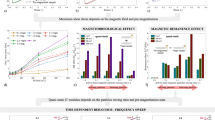Magnetorheological elastomer beam samples were tested in uniaxial tension in magnetic fields of different intensities up to the final rupture. The samples deformed nonlinearly. Their maximum elongation reached 70% and the tensile strength increased by 120% with growing intensity of magnetic field applied.






Similar content being viewed by others
References
J. R. Banerjee, “Free vibration of sandwich beams using the dynamic stiffness method,” Computers & Structures, 81, 1915-1922 (2003).
W. P. Howson and A. Zare, “Exact dynamic stiffness matrix for flexural vibration of three-layered sandwich beams,” Journal of Sound and Vibration, 282, 753-767 (2005).
J. R. Banerjee, C. W. Cheung, R. Morishima, M. Perera, and J. Njuguna, “Free vibration of a three-layered sandwich beam using the dynamic stiffness method and experiment,” International Journal of Solids and Structures, 44, 7543-7563 (2007).
G. Y. Zhou and Q. Wang, “Magnetorheological elastomer-based smart sandwich beams with nonconductive skins,” Smart Mater. Struct., 14, 1001 (2005).
G. Y. Zhou and Q. Wang, “Use of magnetorheological elastomer in an adaptive sandwich beam with conductive skins. Part I: Magnetoelastic loads in conductive skins,” International Journal of Solids and Structures, 43, 5386-5402 (2006).
G. Y. Zhou and Q. Wang, “Use of magnetorheological elastomer in an adaptive sandwich beam with conductive skins. Part II: Dynamic properties,” International Journal of Solids and Structures, 43, 5403-5420 (2006).
H. Deng, X. Gong, and L. Wang, “Development of an adaptive tuned vibration absorber with magnetorheological elastomer,” Smart Mater. Struct, 15, 111-116 (2006).
H. Deng and X. Gong, “Application of magnetorheological elastomer to vibration absorber,” Communications in Nonlinear Science and Numerical Simulation, 13, 1938-1947 (2008).
S. Sun, H. Deng, J. Yang, W. Li, H. Du, G. Alici, and M. Nakano, “An adaptive tuned vibration absorber based on multilayered MR elastomers,” Smart Materials and Structures, 24, 045045 (2015).
W. Choi, Y. **ong, and R. Shenoi, “Vibration Characteristics of Sandwich Beams with Steel Skins and Magnetorheological Elastomer Cores,” Advances in Structural Engineering, 13, 837-847 (2010).
H. Arvin, M. Sadighi, and A. R. Ohadi, “A numerical study of free and forced vibration of composite sandwich beam with viscoelastic core,” Composite Structures, 92, 996-1008 (2010).
D. J. Mead and S. Markus, “The forced vibration of a three-layer, damped sandwich beam with arbitrary boundary conditions,” Journal of Sound and Vibration, 10, 163–175 (1969).
B. Nayak, S. Dwivedyn, and K. Murthy, “Dynamic analysis of magnetorheological elastomer-based sandwich beam with conductive skins under various boundary conditions,” Journal of Sound and Vibration, 330, 1837-1859 (2011).
B. Nayak, S. Dwivedyn, and K. Murthy, “Vibration analysis of a three-layer magnetorheological elastomer embedded sandwich beam with conductive skins using finite element method,” Proceedings of the Institution of Mechanical Engineers, Part C. Journal of Mechanical Engineering Science, 227, 714-729 (2013).
B. Nayak, S. Dwivedyn, and K. Murthy, “Dynamic stability of a rotating sandwich beam with magnetorheological elastomer core,” European Journal of Mechanics A/Solids, 47, 143-155 (2014).
S. Aguib, A. Nour, H. Zahloul, G. Bossis, Y. Chevalier, and P. Lançon, “Dynamic behavior analysis of a magnetorheological elastomer sandwich plate,” International Journal of Mechanical Sciences, 87, 118-136 (2014).
T. Yildirim, M. Ghayesh, W. Li, and G. Alici, “Experimental nonlinear dynamics of a geometrically imperfect magnetorheological elastomer sandwich beam,” Composite Structures, 138, 381-390 (2016).
H. Navazi, S. Bornassi, and H. Haddad, “Vibration analysis of a rotating magnetorheological tapered sandwich beam,” International Journal of Mechanical Sciences, 122, 308-317 (2017).
F. S. Eloy, G. F. A. Gomes, A. C. Ancelotti, da S. S., A. J. F. C. Bombard, and D. M. Junqueira, “Experimental dynamic analysis of composite sandwich beams with magnetorheological honeycomb core,” Engineering Structures, 176, 231-242 (2018).
Y. R. Ataria and B. C. Wang, “Bending and shear behaviour of two layer beams with one layer of rubber recycled aggregate concrete in tension,” Structures, 20, 214-225 (2019).
H. Barman and S. Hegde, “Comprehensive review of parameters influencing the performance of magnetorheological elastomers embedded in beams,” Materials to Day, 26, 2130-2135 (2020).
R. Zabihyan, J. Mergheim, J. P. Pelteret, B. Brands, and P. Steinmann, “FE2 simulations of magnetorheological elastomers: influence of microscopic boundary conditions, microstructures and free space on the macroscopic responses of MREs,” International Journal of Solids and Structures, 193–194, 338-356 (2020).
G. I. Mikhasev, V. A. Eremeyev, K. Wilde, and S. S. Maevskaya, “Assessment of dynamic characteristics of thin cylindrical sandwich panels with magnetorheological core,” Journal of Intelligent Material Systems and Structures, 30, No. 18-19, 2748–2769 (2019).
Acknowledgment
Many thanks to those responsible of the Higher School of Territorial Air Defense (ESDAT), Reghaïa - Algiers, Algeria.
Thanks to the Laboratory of Condensed Matter Physics (LPMC) University of Nice - Sophia Antipolis - France, for supporting for this study. We are also grateful to Messrs George Bossis Research Director Emeritus and Dr. Kuzhir Pavel of LPMC for their help.
Author information
Authors and Affiliations
Corresponding author
Additional information
Russian translation published in Mekhanika Kompozitnykh Materialov, Vol. 57, No. 6, pp. 1171-1180, November-December, 2021. Russian DOI: 10.22364/mkm.57.6.09.
Rights and permissions
About this article
Cite this article
Aguib, S., Chikh, N., Settet, A. et al. Experimental Analysis of the Tensile Behavior of a Hybrid Composite Beam with Adjustable Mechanical Properties. Mech Compos Mater 57, 825–832 (2022). https://doi.org/10.1007/s11029-022-10002-9
Received:
Revised:
Published:
Issue Date:
DOI: https://doi.org/10.1007/s11029-022-10002-9




